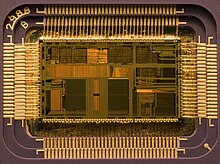Stored-program architecture
Several developers of ENIAC, recognizing its flaws, came up with a
far more flexible and elegant design, which came to be known as the
“stored-program architecture” or
von Neumann architecture. This design was first formally described by
John von Neumann in the paper
First Draft of a Report on the EDVAC,
distributed in 1945. A number of projects to develop computers based on
the stored-program architecture commenced around this time, the first
of which was completed in 1948 at the
University of Manchester in England, the
Manchester Small-Scale Experimental Machine (SSEM or “Baby”). The
Electronic Delay Storage Automatic Calculator
(EDSAC), completed a year after the SSEM at Cambridge University, was
the first practical, non-experimental implementation of the
stored-program design and was put to use immediately for research work
at the university. Shortly thereafter, the machine originally described
by von Neumann's paper—
EDVAC—was completed but did not see full-time use for an additional two years.
Nearly all modern computers implement some form of the stored-program
architecture, making it the single trait by which the word “computer”
is now defined. While the technologies used in computers have changed
dramatically since the first electronic, general-purpose computers of
the 1940s, most still use the von Neumann architecture.
Beginning in the 1950s,
Soviet scientists
Sergei Sobolev and
Nikolay Brusentsov conducted research on
ternary computers, devices that operated on a base three numbering system of -1, 0, and 1 rather than the conventional
binary numbering system upon which most computers are based. They designed the
Setun, a functional ternary computer, at
Moscow State University. The device was put into limited production in the Soviet Union, but supplanted by the more common binary architecture.

No comments:
Post a Comment